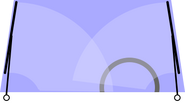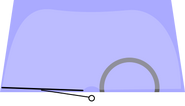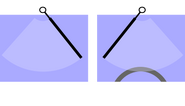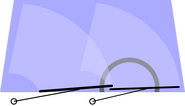| This article needs additional citations for verification. Please help improve this article by adding citations to reliable sources. Unsourced material may be challenged and removed. (July 2008) |
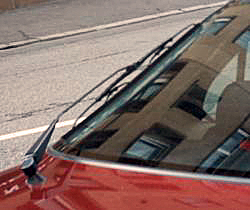
Windscreen wiper on a parked car. In this common design, the force from the arm is distributed evenly with a series of linkages known as a whippletree.
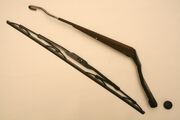
A common windscreen wiper arm and blade
A windscreen wiper or windshield wiper is a device used to remove rain and debris from a windscreen or windshield. Almost all motor vehicles, including trains, aircraft and watercraft, are equipped with such wipers, which are usually a legal requirement.
A wiper generally consists of an arm, pivoting at one end and with a long rubber blade attached to the other. The blade is swung back and forth over the glass, pushing water from its surface. The speed is normally adjustable, with several contstant speeds and often one or more "intermittent" settings. Most automobiles use two synchronized radial type arms, while many commercial vehicles use one or more pantograph arms.
History[]

Windscreen wiper arms and blades on a 1954 German automobile. using a simple radial design with no visible linkages
Early versions[]
The inventor Mary Anderson is credited with devising the first operational windshield wiper in 1903.[1][2] In Anderson's patent, she called her invention a "window cleaning device" for electric cars and other vehicles. Operated via a lever from inside a vehicle, her version of windshield wipers closely resembles the windshield wiper found on many early car models. Anderson had a model of her design manufactured, then filed a patent (US 743,801) on June 18, 1903 that was issued to her by the US Patent Office on November 10, 1903.[3][4]
Irish born inventor James Henry Apjohn (1845–1914) devised a method of moving two brushes up and down on a vertical plate glass windscreen in 1903. This was patented in the UK.
In April 1911, a patent for windscreen wipers was registered by Sloan & Lloyd Barnes, patent agents of Liverpool, England, for Gladstone Adams of Whitley Bay. The first designs for the windscreen wiper are also credited to Polish concert pianist Józef Hofmann, and Mills Munitions, Birmingham who also claimed to have been the first to patent windscreen wipers in England.

Street vendor of windscreen wipers in Mexico
John R. Oishei (1886-1968) formed the Tri-Continental Corporation in 1917. This company introduced the first windshield wiper, Rain Rubber, for the slotted, two-piece windshields found on many of the automobiles of the time. Today Trico Products is one of the world's leading manufacturers of windshield wiping systems, windshield wiper blades and refills, with wiper plants on five continents.[citation needed] Bosch has the world's biggest windscreen wiper factory in Tienen, Belgium, which produces 350,000 wiper blades every day.[5]
Inventor William M. Folberth applied for a patent for an automatic windscreen wiper apparatus in 1919, which was granted in 1922. It was the first automatic mechanism.[clarification needed] Trico later settled a patent dispute with Folberth and purchased Folberth's Cleveland company, the Folberth Auto Specialty Co. The new vacuum-powered system quickly became standard equipment on automobiles, and the vacuum principle was in use until about 1960. In the late 1950s, a feature common on modern vehicles first appeared, operating the wipers automatically for two or three passes when the windshield washer button was pressed, making it unnecessary to manually turn the wipers on as well. Today, an electronic timer is used, but originally a small vacuum cylinder mechanically linked to a switch provided the delay as the vacuum leaked off.
Intermittent wipers[]
In 1963, the first modern intermittent wipers were invented by Robert Kearns, an engineering professor at Wayne State University in Detroit, Michigan.[1] The road to intermittent wipers began earlier, on his wedding night in 1953, when an errant champagne cork shot into Kearn's left eye, which eventually went almost completely blind. Nearly a decade later, Kearns was driving his Ford Galaxie through a light rain, and the constant movement of the wiper blades irritated his already troubled vision. He got to thinking about the human eye, which has its own kind of wiper, the eyelid, that automatically closes and opens every few seconds. Finally in 1963, Kearns put his idea into action, building the first intermittent wiper system using off-the-shelf electronic components. Kearns showed it to the Ford Motor Company, and proposed manufacturing the design.
In the Kearns design, the interval between wipes was determined by the rate of current flow into a capacitor. When the charge in the capacitor reached a certain voltage, the capacitor was discharged, activating the wiper motor for one cycle. After extensive testing, Ford executives decided to offer a design similar to Kearns’ intermittent wipers as an option on the company's Mercury line, beginning with the 1969 models.[1] Kearns and Ford became involved in a multi-year patent dispute that eventually had to be resolved in court.[6] A fictionalized version of the Kearns invention and patent lawsuit was used for the 2009 film Flash of Genius, which is billed as "based on the true story", but does not claim to be historically accurate in all respects.
Kearns may not, in fact, have been the original inventor of the intermittent wiper concept. John Amos, an engineer for the UK automotive engineering company Lucas Industries, was the first to file a patent for an intermittent wiper (US Patent #3,262,042, issued 1966), two years before Kearns applied (US Patent #3,351,836, issued 1967).[7][8] One notable difference is that the Amos patent describes an electromechanical device, whereas Kearns proposed a solid-state electronic circuit.
In March 1970, Citroën introduced rain-sensitive intermittent windscreen wipers on their SM model. When the intermittent function was selected, the wiper would make one swipe. If the windscreen was relatively dry, the wiper motor drew high current, which set the control circuit timer to delay the next wipe longest. If the motor drew little current, it indicated that the glass was wet, setting the timer to minimize the delay.
Headlight wipers[]
In 1970, Saab Automobile introduced headlight wipers across their product range. These operated on a horizontal reciprocating mechanism, with a single motor. They were later superseded by a radial spindle action wiper mechanism, with individual motors on each headlamp.
Power[]

Pneumatic motor drive on a train windscreen wiper. The lever on the motor operates a valve to supply pressurized air.

Lever mechanism of a windscreen wiper. The Motor in the middle converts the circular rotation to a intermittent rotation. The lever arms has different lengths, so the stop position at the reverse point is different.
Wipers may be powered by a variety of means, although most in use today are powered by an electric motor through a series of mechanical components, typically two 4-bar linkages in series or parallel.
Vehicles with air operated brakes sometimes use pneumatic wipers, powered by tapping a small amount of pressurized air from the brake system to a small air operated motor mounted on or just above the windscreen. These wipers are activated by opening a valve which allows pressurized air to enter the motor.
Early wipers were often driven by a vacuum motor powered by manifold vacuum. This had the drawback that manifold vacuum varies depending on throttle position, and is almost non-existent under wide-open throttle, when the wipers would slow down or even stop. This problem was overcome somewhat by using a combined fuel/vacuum booster pump.
Some cars, mostly from the 1960s and 1970s, had hydraulically driven wipers.[citation needed]
On the earlier Citroën 2CV, the windscreen wipers were powered by a purely mechanical system, a cable connected to the transmission; to reduce cost, this cable also powered the speedometer. The wipers' speed was therefore variable with car speed. When the car was waiting at an intersection, the wipers were not powered, but a handle under the speedometer allowed the driver to power them by hand.[citation needed]
Geometry[]

A common alternative design for a "wiper" (also called a clear view screen) on a ship. A round portion of the windscreen has two layers, the outer one of which is spun at high speed to shed water.

Simple parallelogram linkages on a boat windscreen
Most wipers are of the pivot (or radial) type: they are attached to a single arm, which in turn is attached to the motor. These are commonly found on many cars, trucks, trains, boats, airplanes, etc.
Another type of wiper design is pantograph-based (see Fig. 6, below), which are used on many commercial vehicles, especially buses with large windscreens. Pantograph wipers feature two arms for each blade, with the blade assembly itself supported on a horizontal bar connecting the two arms. One of the arms is attached to the motor, while the other is on an idle pivot.[citation needed] The pantograph mechanism, while being more complex, allows the blade to cover more of the windscreen on each wipe. However, it also usually requires the wiper to be "parked" in the middle of the windscreen, where it may partially obstruct the driver's view when not in use. Some larger cars in the late '70s and early '80s, especially LH driver American cars[citation needed], had a pantograph wiper on the driver's side, with a conventional pivot on the passenger side.
Mercedes-Benz pioneered a system called the Monoblade, based on cantilevers (see Fig. 5, below), in which a single arm extends outward to reach the top corners of the windscreen, and pulls in at the ends and middle of the stroke, sweeping out a somewhat 'M'-shaped path. This way, a single blade is able to cover more of the windscreen, and displace the residual streaks away from the center of the windscreen.
Asymmetric wiper arrangements are usually configured to clear more windscreen area on the driver's side, and so are mostly mirrored for left and right-hand-drive vehicles. One exception is found on Renault Clios, where the wipers always sweep towards the left. On right-hand-drive models, a linkage allows the right-hand wiper to move outwards towards the corner of the windscreen and clear more area.
Unusual wiper geometries[]
- Works as would Fig. 1, but uses a large, single wiper
- Renault Twingo Mk1
- Citroen C1
- Peugeot 107
- Toyota Aygo
- Datsun Go
- Datsun Go+
- Toyota Etios
- Toyota Yaris (XP130)
Other features[]

Windscreen washer in operation
Windscreen washer[]
- See also: Windshield washer fluid
Most windscreen wipers operate together with a windscreen (or windshield) washer; a pump that supplies a mixture of water, alcohol, and detergent (a blend called windshield washer fluid) from a tank to the windscreen. The fluid is dispensed through small nozzles mounted on the Bonnet(hood in US). Conventional nozzles are usually used, but some designs use a fluidic oscillator to disperse the fluid more effectively.
In warmer climates, water may also work, but it can freeze in colder climates, damaging the pump. Although automobile antifreeze is chemically similar to windscreen wiper fluid, it should not be used because it can damage paint. The earliest documented idea for having a windshield wiper unit hooked up to a windshield washer fluid reservoir was in 1931, Richland Auto Parts Co, Mansfield, Ohio [9]
Hidden wipers[]
Some larger cars are equipped with hidden wipers (or depressed-park wipers). When wipers are switched off in standard non-hidden designs, a "parking" mechanism or circuit moves the wipers to the lower extreme of the wiped area near the bottom of the windscreen, but still in sight. For designs that hide the wipers, the windscreen extends below the rear edge of the hood, and the wipers park themselves below the wiping range at the bottom of the windscreen, but out of sight.
Rain-sensing wipers[]
Vehicles are now available with driver-programmable intelligent (automatic) windscreen wipers that detect the presence and amount of rain using a rain sensor. The sensor automatically adjusts the speed and frequency of the blades according to the amount of rain detected. These controls usually have a manual override.
Rain-sensing windscreen wipers appeared on various models in the late 20th century, one of the first being Nissan's 200SX/Silvia. As of early 2006[update], rain-sensing wipers are optional or standard on all Cadillacs and most Volkswagens, and are available on many other mainstream manufacturers.
Headlight wipers[]
Some vehicles have small wipers or washers on the headlights. In some recent vehicles, these have been replaced with a powerful jet spray, without wipers.
Rear wipers[]
Some vehicles are fitted with wipers (with or without washers) on the back window as well. Rear-window wipers are typically found on hatchbacks, station wagons / estates, sport utility vehicles, minivans, and some sports cars. Jack Reynolds of Ford Motor Company invented the rear windshield wiper in 1972, while working at the Ford Motor plant in Mahwah, New Jersey.[10] They were first implemented in the 1970s, but SUVs did not use them until the 1980s.
See also[]
- Automobile ancillary power
References[]
- ↑ 1.0 1.1 1.2 "The Windshield Wiper". American Heritage.
- ↑ "Windshield Wipers". Massachusetts Institute of Technology.
- ↑ "Mary Anderson". Encyclopedia of Alabama.
- ↑ "Window-Cleaning Device". United States Patent and Trademark Office.
- ↑ Robert Bosch GmbH (2009-01-16). "BoschLive". Bosch.com.au. Retrieved on 2011-09-23.
- ↑ Schudel, Matt (26 February 2005). "Accomplished, Frustrated Inventor Dies". Retrieved on 12 December 2011.
- ↑ "Electrical Operating Circuit for Vehicle Windscreen Wipers". United States Patent and Trademark Office.
- ↑ "Windshield Wipers". United States Patent and Trademark Office.
- ↑ Windshield Freed Of Snow With Alcohol Wiper", February 1931, Popular Mechanics article bottom half of page
- ↑ (1967) Windshield Wipers. United States Patent and Trademark Office, 11.
External links[]
- How Windshield Wipers Work at HowStuffWorks
| ||||||||||||||||||||||||||||||||||||||||||||||||||
| ||||||||||||||||||||||||||||||||||||||||||||||||||||||||||||||||||||||||||||||||||||||||||||||||||||||||||||||||||||||||||||||||||||||||||||||||||||||||||||||||||||||||||||||||||||||||||||||||||||||||||||||||||||||
| This page uses some content from Wikipedia. The original article was at Windscreen wiper. The list of authors can be seen in the page history. As with Tractor & Construction Plant Wiki, the text of Wikipedia is available under the Creative Commons by Attribution License and/or GNU Free Documentation License. Please check page history for when the original article was copied to Wikia |


